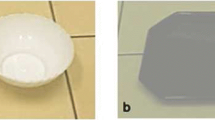Abstract
Pigeons given a simultaneous spatial discrimination reversal, in which a single reversal occurs at the midpoint of each session, consistently show anticipation prior to the reversal as well as perseveration after the reversal, suggesting that they use a less effective cue (time or trial number into the session) than what would be optimal to maximize reinforcement (local feedback from the most recent trials). In contrast, rats (Rattus norvegicus) and humans show near-optimal reversal learning on this task. To determine whether this is a general characteristic of mammals, in the present research, pigeons (Columba livia) and dogs (Canis familiaris) were tested with a simultaneous spatial discrimination mid-session reversal. Overall, dogs performed the task more poorly than pigeons. Interestingly, both pigeons and dogs employed what resembled a timing strategy. However, dogs showed greater perseverative errors, suggesting that they may have relatively poorer working memory and inhibitory control with this task. The greater efficiency shown by pigeons with this task suggests they are better able to time and use the feedback from their preceding choice as the basis of their future choice, highlighting what may be a qualitative difference between the species.




Similar content being viewed by others
References
Ashton RL, De Lillo C (2011) Association, inhibition, and object permanence in dogs’ (Canis familiaris) spatial search. J Comp Psychol 125:194–206
Bentosela M, Mustaca AE (2007) Communication between domestic dogs (Canis familiaris) and humans. Rev Lat Am Psico 39:375–387
Bentosela M, Barrera G, Jakovcevic A, Elgier AM, Mustaca AE (2008) Effect of reinforcement, reinforcer omission and extinction on a communicative response in domestic dogs (Canis familiaris). Behav Process 78:464–469
Bentosela M, Jakovcevic A, Elgier AM, Mustaca AE, Papini MR (2009) Incentive contrast in domestic dogs (Canis familiaris). J Comp Psychol 123:125
Bitterman ME (1975) The comparative analysis of learning. Science 188:699–709
Bitterman ME, Mackintosh NJ (1969) Habit-reversal and probability-learning: rats, birds and fish. In: Gilbert RM, Southerland NS (eds) Animal discrimination learning. Academic Press, New York, NY
Elgier AM, Jakovcevic A, Mustaca AE, Bentosela M (2009a) Learning and owner–stranger effects on interspecific communication in domestic dogs (Canis familiaris). Behav Process 81:44–49
Elgier AM, Jakovcevic A, Barrera G, Mustaca AE, Bentosela M (2009b) Communication between domestic dogs (Canis familiaris) and humans: dogs are good learners. Behav Process 81:402–408
Erdöhegyi A, Topál J, Virányi Z, Miklósi Á (2007) Dog-logic: inferential reasoning in a two-way choice task and its restricted use. Anim Behav 74:725–737
Frank H (2011) Wolves, dogs, rearing and reinforcement: complex interactions underlying species differences in training and problem-solving performance. Behav Gen 41:830–839
Gossette RL, Gossette MF, Riddell W (1966) Comparisons of successive discrimination reversal among closely and remotely related avian species. Anim Behav 14:560–564
Hare B, Tomasello M (2005) Human-like social skills in dogs? Trends Cogn Sci 9:439–444
Laude JR, Pattison KF, Zentall TR (2012) Hungry pigeons make suboptimal choices, less hungry pigeons do not. Psychon Bull Rev 19:884–891
Laude JR, Stagner JP, Rayburn-Reeves R, Zentall TR (2014) Midsession reversals with pigeons: visual versus spatial discriminations and the intertrial interval. Learn Behav 42:40–46
Mackintosh NJ (1965) Selective attention in animal discrimination learning. Psychol Bull 64:124–150
Mackintosh NJ (1969) Comparative studies of reversal and probability learning: rats, birds, and fish. In: Gilbert RM, Southerland NS (eds) Animal discrimination learning. Academic Press, New York, NY, pp 137–162
Mackintosh NJ, McGonigle B, Holgate V, Vanderver V (1968) Factors underlying improvement in serial reversal learning. Can J Psychol 22:85–95
MacLean EL, Hare B, Nunn CL, Addessi E, Amici F, Anderson RC, Aureli F, van Schaik CP et al (2014) The evolution of self-control. Proc Natl Acad Sci 111:E2140–E2148
Macpherson K, Roberts WA (2010) Spatial memory in dogs (Canis familiaris) on a radial maze. J Comp Psychol 124:47
Miklósi Á (2007) Dog behaviour, evolution and cognition. Oxford University Press, Oxford
Miklósi Á, Topál J, Csányi V (2004) Comparative social cognition: what can dogs teach us? Anim Behav 67:995–1004
Milgram NW (2003) Cognitive experience and its effect on age-dependent cognitive decline in beagle dogs. Neurochem Res 28:1677–1682
Miller HC, Pattison KF, DeWall CN, Rayburn-Reeves R, Zentall TR (2010) Self-control without a “self”? Common self-control processes in humans and dogs. Psychol Sci 21:534–538
Miller HC, DeWall CN, Pattison K, Molet M, Zentall TR (2012) Too dog tired to avoid danger: self-control depletion in canines increases behavioral approach toward an aggressive threat. Psychon Bull Rev 19:535–540
Olton DS, Samuelson RJ (1976) Remembrance of places passed: spatial memory in rats. J Exp Psychol Anim Behav Process 2:97–116
Rayburn-Reeves RM, Molet M, Zentall TR (2011) Simultaneous discrimination reversal learning in pigeons and humans: anticipatory and perseverative errors. Learn Behav 39:125–137
Rayburn-Reeves RM, Laude JR, Zentall TR (2013a) Pigeons show near-optimal win-stay/lose-shift performance on a simultaneous-discrimination, midsession reversal task with short intertrial intervals. Behav Process 92:65–70
Rayburn-Reeves RM, Stagner JP, Kirk CR, Zentall TR (2013b) Reversal learning in rats (Rattus norvegicus) and pigeons (Columba livia): qualitative differences in behavioral flexibility. J Comp Psychol 127:202
Savastano HI, Miller RR (2004) Behavioral momentum in Pavlovian conditioning and the learning/performance distinction. Behav Brain Sci 27:694–695
Ward RD, Odum AL (2006) Effects of prefeeding, intercomponent-interval food, and extinction on temporal discrimination and pacemaker rate. Behav Process 71:297–306
Warren JM (1965) The comparative psychology of learning. Annu Rev Psychol 16:95–118
Warren JM (1973) Learning in vertebrates. In: Dewsbury DA (ed) Comparative psychology: a modem survey. McGraw-Hill, New York, NY, pp 471–509
Warren JM (1974) Possibly unique characteristics of learning by primates. J Hum Evol 3:445–454
Author information
Authors and Affiliations
Corresponding author
Ethics declarations
Conflict of interest
The authors confirm that they have no conflict of interest.
Ethical statement
All applicable international, national, and/or institutional guidelines for the care and use of animals were followed.
Rights and permissions
About this article
Cite this article
Laude, J.R., Pattison, K.F., Rayburn-Reeves, R.M. et al. Who are the real bird brains? Qualitative differences in behavioral flexibility between dogs (Canis familiaris) and pigeons (Columba livia). Anim Cogn 19, 163–169 (2016). https://doi.org/10.1007/s10071-015-0923-8
Received:
Revised:
Accepted:
Published:
Issue Date:
DOI: https://doi.org/10.1007/s10071-015-0923-8




